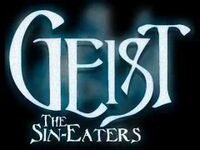Geist: The Sin-Eaters: Difference between revisions
1d4chan>CoolGuy99 m (→Manifestations) |
1d4chan>CoolGuy99 |
||
| Line 113: | Line 113: | ||
Some Manifestations allow for the use of Anachrotech, pieces of technology that have fallen into disuse. They act as a kind of focus for the Manifestation, adding a dice modifier based on how old the object is. If the object was made before 1960 there is no modifier involved. For every decade onwards (60s, 70s, 80s, 90s, and 2000s) there is a cumulative -1 modifier to a max of -5 in place while older objects made in the 40s, 20s or even the 19th century add a cumulative +1 modifier to a max of +3. A good rule of thumb is that you'll have a MUCH easier time messing with a Ford Model T than a Tesla Model 3. | Some Manifestations allow for the use of Anachrotech, pieces of technology that have fallen into disuse. They act as a kind of focus for the Manifestation, adding a dice modifier based on how old the object is. If the object was made before 1960 there is no modifier involved. For every decade onwards (60s, 70s, 80s, 90s, and 2000s) there is a cumulative -1 modifier to a max of -5 in place while older objects made in the 40s, 20s or even the 19th century add a cumulative +1 modifier to a max of +3. A good rule of thumb is that you'll have a MUCH easier time messing with a Ford Model T than a Tesla Model 3. | ||
In 2e, Manifestations have been renamed Haunts. | |||
===Keys=== | ===Keys=== | ||
Revision as of 08:10, 16 April 2020
| Geist: The Sin-Eaters | ||
|---|---|---|
 |
||
| RPG published by White Wolf / CCP |
||
| Rule System | Storytelling System | |
| Authors | Justin Achilli et al | |
| First Publication | 2009/2012/TBD | |
A New World of Darkness RPG, much removed from but sharing themes with the Old World of Darkness's Wraith: The Oblivion and Mummy: The Resurrection. Once, you were human. And then you died. But in the underworld, you were approached by a Geist, the ghost of someone who's been dead so long they remember nothing about their mortal existence save for how they died. It offered you a bargain: go back to the land of the living, and get to live your life again but in return, you gotta share your body with the Geist, who wants to experience life again. Naturally, you accepted and through that became a titular Sin-Eater. Now you have a crazy-weird ghost sharing your body and you can talk to ghosts, but you have all sorts of awesome necromantic powers and you're not dead anymore.
Like Changeling: The Lost, GtSE is a case of White Wolf reversing the mood set of an OWoD gameline and thus managing to make a formerly unpopular idea popular. GtSE is a pretty welcome breath of fresh air in the NWoD since its themes are a huge difference to the general Wangsting that is so prevalent in the other game-lines. The tone is akin to a celebration of being alive, you cheated death so you may as well make the most of your new life before you kick the bucket for real. Think of the Mexican Day of the Dead or a New Orleans funeral and you won't be too far off.
It's one of the only two NWoD games pre-upgrade to the God Machine Chronicles where supernaturals had morality meters that actually managed to make them feel inhuman, instead of just being ridiculous hamhanded "tack on some extra race-appropriates 'sins' and call it done". The other was Werewolf: The Forsaken. Instead, the Bound (as the mortal part of the pair is called) has Synergy, which represents how well he/she works with the Geist. High Synergy means that the two halves work together effectively as a single individual, while low Synergy means that the mortal and the Geist no longer share the same goals. Additionally, if you die the Geist can bring you back but you'll take a major hit to your maximum Synergy in the process and you'll be forced to see the death of the person who was chosen to die in your place. At its lowest point, a Sin Eater may end up as one of the Wretched: a Geist and a mortal unable to share the same body, resulting first in a form of split personality (as the Geist and mortal struggle for control), ending with the Geist taking total control of its new meat-puppet.
While the premise works, nearly everything else doesn't. Only one book was ever made and it was rushed due to it starting development right when White Wolf was bought out by CCP Games. The corner-cutting needed to get out before the management change was so severe that it's earned the moniker "Geist: the Underdeveloped and Unedited". It took three years for an errata'd "version 1.1" to be released and to no one's surprise, the game still has problems.
A second edition is now in the works.
Thresholds
Water is wet, fire burns and NWoD games have a "racial" and a "class" splat. Your Threshold is your "race", determining how you died. This, in turn, determines which Keys you have access to from the start, as well as which of the Horsemen of the Apocalypse they consider to be their patron.
The Forgotten
Those Who Died By Chance. The unlucky sods who got struck by lightning, had their skulls cracked by meteors, stuck a shovel in the ground and hit a bomb, stepped on a marble and broke their neck, or just about any other death that's through stupid misfortune. This is more or less the DIY faction of Geist: they're the Extempores, the Orphans, the Caitiff and so on. If your death is down to sheer bad luck, a bizarre coincidence or something utterly out of your hands, then you're a Forgotten. Their Keys are Industrial and Pyre-Flame, and their patron is the Grey Horseman (Chance).
The Pious
Those Who Died By Faith. Introduced in Dark Eras Companion, these are the people who died during extreme acts of faith, like by being crucified and then bleeding out. Their first Key is always related to how they died, whilst the second one is chosen by the storyteller, and they have no patron Horseman.
The Prey
Those Who Died By Nature. Victims of the elements, nature, and animals. Bitten by poisonous spiders, crushed by a hippopotamus, caught in an avalanche, mudslide, hurricane, or volcanic eruption, swept away in a river and drowned, got caught by hypothermia or overheated: all of these will create a Prey. Their Geists tend to look inhuman: animals, plants and elementals are all favorites. Their Keys are Primal and Grave-Dirt, and their patron is the Pale Horseman (Death).
The Silent
Those Who Died By Deprivation. Those who died of hunger and thirst, were neglected or suffocated, or otherwise died because nobody cared enough to prevent them from dying are all Silent. They tend to resent their Geists, who look like hollow versions of their Sin-Eater or resemble their death in some way. Their Keys are Stillness and Cold Wind, and their patron is the Black Horseman (Famine).
The Stricken
Those Who Died By Pestilence. The sick and poisoned, those who died by viruses, bacteria, infections, and all that stuff. Their Keys are Phantasm and Tear-Stained, and their patron is the White Horseman (Pestilence).
The Torn
Those Who Died By Violence. War, violence and all other deaths due to conflict generate the Torn. This does not always make them the combat splat: while most of them do favor the physical Attributes, many of them favor social Attributes to act as instigators or even peacemakers. Their Keys are Stigmata and Passion, and their patron is the Red Horseman (War).
-
The Forgotten
-
The Prey
-
The Silent
-
The Stricken
-
The Torn
Burden
The 2e replacement for Thresholds. Unlike the Thresholds, the Burden isn't about how you died so much as why you struck the Bargain.
Abiding
These Bound died forgotten and insignificant, and return to life in order to leave a legacy that's more substantial than an unmarked grave.
Bereaved
They seek someone they lost. That, someone, may be living, or they may be dead- either way, the Bereaved will tear the Underworld apart if it means they can be reunited with their loved ones.
Hungry
You know the saying "you can't take it with you"? These guys heard that and decided that they'd just have to come back for their stuff instead.
Kindly
Bound who died before they could put right some wrong they committed and came back to make amends for it.
Vengeful
The Vengeful blame someone for their wrongful death and want to get even.
-
Abiding
-
Bereaved
-
Hungry
-
Kindly
-
Vengeful
Archetypes
For Geist, the "class" splat is your Archetype, aka how your death changed you. Each Archetype has a way it uses its Manifestations in the eyes of the Sin-Eater's Virtue and Vice. When a Manifestation is used in such a way it requires no Plasm, making it free to use (but secondary effects still use Plasm). Aren’t used in 2e, although some are renamed and used as Krewe archetypes.
Advocate
Advocates are there to help spirits move on in life. The Virtuous do so to help a ghost to a better place while the Vicious do so to gain something out of it themselves.
Bonepicker
Bonepickers seek to make their mortal lives as comfortable as possible by amassing large amounts of wealth and resources. Virtuous Sin-Eaters do this so that they can help other people while the Vicious do so for selfish reasons.
Celebrant
Celebrants are the mandatory "they're totally not there just for sex, guys" splat. They embrace life and all the fun stuff it offers, seeking thrills and desires so that they can make the most of their return from the grave. The Virtuous take a careful and moderate approach to their revels, while the Vicious are full-on Slaanesh tier.
Gatekeeper
Gatekeepers are the border watch between the worlds of the spirits and the living. Virtuous ones take a gentle but stern approach to keep newcomers out and drive out those who are already here while the Vicious take the violent and easy approach.
Mourner
Mourners take care of spirits and their unsated passions. The Virtuous help ghosts come to terms with their deaths while the Vicious sate these passions for themselves without caring for anyone else.
Necromancer
Necromancers revel in their powers and seek to learn more. Virtuous ones do so to help the living and other ghosts while Vicious ones do so to get ahead of their rivals and takes knowledge from others rather than find it out themselves.
Pilgrim
Pilgrims guide ghosts through the land of the dead. A ghost must shed its emotions and its humanity before it can move on to its final reward. This can be done with both ghosts and people: by making them forget connections, severing bonds, or helping them move on a Pilgrim fulfills its purpose. The Virtuous help people with the chaos and tragedy in life and guide them to move on while the Vicious tend to force them to do so against their will.
Reaper
Reapers are the required edgelord splat, the judges of the living and the dead. They seek out those who sin and judge them, killing the unworthy and sending them to the Underworld. Virtuous Reapers do this out of compassion and love while the Vicious Reapers seek to gain from their killings, use people first or do so for the lulz.
Krewe Archetypes
2nd Edition is slated to add additional Krewe Archetypes, similar to how werewolf packs were expanded on in 2nd edition. Like the basic version, they help to define how the Krewe goes about its business of helping the dead find peace and making the Underworld less of a horrible shithole.
Keys and Manifestations
The powers of Geist. What Manifestations do is determined by what Manifestation is used and what type of Key is used. The former come in seven types and determine the rough type of the effect, while the latter determines what its effect actually is. There are ten Keys and seven Manifestations, creating a total of seventy possible powers. Each of these Manifestations has five levels of power, represented by the traditional dots. The more dots you have in a Manifestation the more it can do, though some Manifestations require the spending of additional Plasma to use it.
Some Manifestations allow for the use of Anachrotech, pieces of technology that have fallen into disuse. They act as a kind of focus for the Manifestation, adding a dice modifier based on how old the object is. If the object was made before 1960 there is no modifier involved. For every decade onwards (60s, 70s, 80s, 90s, and 2000s) there is a cumulative -1 modifier to a max of -5 in place while older objects made in the 40s, 20s or even the 19th century add a cumulative +1 modifier to a max of +3. A good rule of thumb is that you'll have a MUCH easier time messing with a Ford Model T than a Tesla Model 3.
In 2e, Manifestations have been renamed Haunts.
Keys
- Cold Wind: Control over air and wind; chill the room or create gale-force winds. Based on the Tibetian 'Sky Funeral' (leaving the body for the animals and elements).
- Grave-Dirt: Control over rock and soil; shift the earth and bury your enemies alive. Based on burying the dead, obviously.
- Pyre-flame: FIRE! To destroy what you've done! FIRE! To end all you've become! It can be a harmless illusion, a psychosomatic hallucination or the real deal. Based on cremation.
- Tear-stained: Water; Make them drown or feel like they're drowning. Based on burial at sea.
- Industrial: Technology, especially the previously mentioned Anachrotech; mess with the lights or make that car drive itself. Based on industrial accidents and the propensity specters have for messing with TVs and phones.
- Passion: Emotions; rage, sorrow, terror. Create maddening illusions or shift the mood of the room. Based on the strong emotions that can accompany a death.
- Phantasmal: The Etherial; bring apparitions into the world both illusionary and very real. You can even manifest your Geist to terrify and destroy.
- Primeval: Nature; control animals and plants alike. Based on old pagan rites, such as animal sacrifice.
- Stigmata: Blood; manipulate it, harness it, turn it into sick-ass razor whips. Based on old religious correlations between blood and life force, hence the term "lifeblood".
- Stillness: The calm and quiet after death AKA necromancy.
- Stygian: Death itself; not to be trifled with. Seriously, using it requires serious mojo and makes you take a hit to your Synergy EVERY time it's used.
Manifestations/Haunts
- Boneyard: Affect the surounding area.
- Caul: Change and warp your very being.
- Curse: Affect others, typically passively.
- Marionette: Affect and manipulate objects.
- Oracle: Turn to your Geist for insight beyond the mortal realm.
- Rage: Rip everything and everyone around you TO FUCKING SHREDS!
- Shroud: Shield yourself from harm.
- Pit: Channel the Underworld itself through your Geist. As with the Stygian Key, using this will hurt your Synergy and likely overwhelm you. Only those unscrupulous, desperate, or truly batshit bonkers should consider using it.









